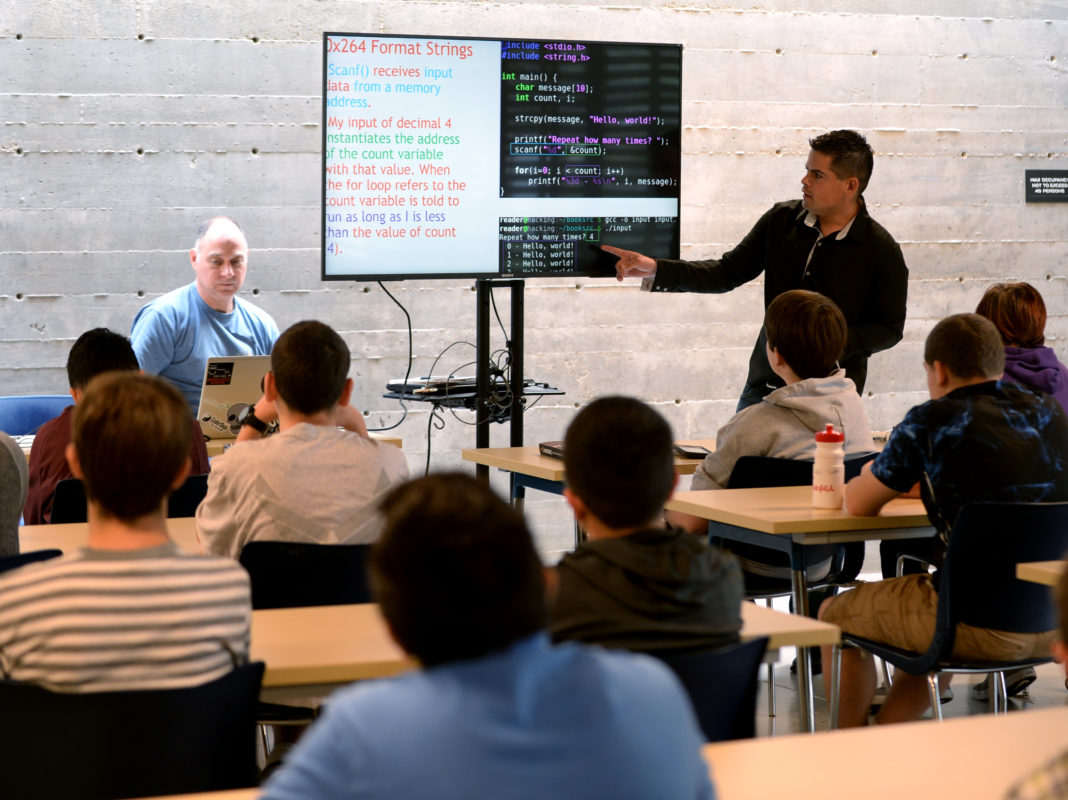Back in the day, coding was taken as this sacred, hyper-intellectual skill that only men could possess. But the scope of programming has increased way beyond that and so has the importance of that skill. In a world where virtual machines are replacing human labor, it takes something to make those machines. Programming has become an irreplaceable skill in this world of technology. So learning it from an early age can never go wrong. So if your child decides to take it up as a hobby, it can actually turn into a very tangible career. In this blog, we will discuss the different ways you can opt for to develop an interest in and teach your child programming.
The Why
Teaching kids to code comes with a lot of benefits other than just acquiring a modern-day skill:
• Develops problem-solving skills
Coding develops logical computational thinking in children. This means, whenever they are faced with a problem in the code, they look at it in a very logical sense, and break it down to smaller, more manageable problems. And naturally, they will apply this same learning in real life as well.
• Encourages Creativity
In today’s modern world, every child has a phone or a tablet in their hands, instead of just consuming content from the internet, it is refreshing to see kids taking an interest in actually building that content. So coding like any other regional language teaches the child to express themselves creatively through building games, apps and more.
• It is fun
Coding may seem like a very techy logic based, boring activity at first. But it is far from it. It is challenging and fun at the same time. Especially for the children, creating something right from scratch can be quite thrilling. And with the right sources, it will also be very easy for them to get started!
• It improves communication skills

Communication is a life-long skill that a human being needs to possess. You have to converse everywhere you go in life. It may seem off at first, but coding really helps to make better and clearer conversations. It will help your child explain complex things in a simple manner as with coding they naturally get accustomed to thinking to the square. And when you learn something at a young age it stays with you longer.
• It helps them be more persistent
Coding also engrains discipline and patience in children. When coding a project be it small, there will be many challenges on the way, and tempt to finish the product often wins over the frustration of giving up on it. So it develops a skill of problem-solving by actively looking for solutions which they apply even in their personal life.
• Improves Teamwork
If there are multiple children who are working on a project together. It helps the children to cooperate and learn how to work in a team together. This also helps the children to see beyond race and gender and other social constraints. It is merely about children coming together with a common love for programming. There are a lot of workshops and seminars where your child can make more connections.
• Programmers are in high-demand
We are moving towards a technology-centered world. In such a time, if you have coding in your skillset it will be extremely helpful when your child is applying for colleges, internships or jobs. Most of the other jobs are slowly becoming replaceable by machines so it is a great idea to teach your kids how to make those machines themselves.
WAYS TO TEACH THEM HOW TO CODE
Enough of the ‘why’ now let’s get to the core of this blog. Let’s discuss what are some practical ways in which you can actually get your kid to learn to code.
1. First, let them learn ANYTHING

Even as a tiny toddler, you did not simply follow instructions. Imagine the horror if your mother kept screaming at you to start walking when you had no idea what that word even meant. You do a particular thing and then you have a name for it; it doesn’t work the other way round for them. So don’t try to sell them the idea of learning code. Either do it in front of them or explain to them what exactly it is. Excite them on how they will be able to make something from scratch. Show them videos about coding. Let them know that their favorite games/apps are all made of code and they can make one too! That should definitely excite them.
But before that, make sure that they are familiarised with the concept of learning in general. Have they learned to fill a water bottle or tie their shoes? Basically, any task that starts from one point and finishes with achievement with a few steps. This will give them a clear idea about what coding really is.
2. Let them step out of the box
Coding for kids is not really a new concept. It has picked up quite well. There are a lot of Science fairs and workshops that are technology-based that your child can attend, to get a deeper insight into programming. Internationally there are programs like GirlsWhoCode, which offer summer camps, workshops, and courses on Coding for girls. They are not just limited to programming, they delve into other subjects like robotics, CSS, etc. Even in India, there are a lot of companies like Codezen and Mindchamp that conduct coding classes workshops and more.
Sometimes, there is a lack of motivation when it comes to taking an initiate right from the comforts of your home. Children need that extra push that comes with these outdoor events. This way, they can also make friends who share and interests and they can then motivate each other further on.
3. Find them a real-life Coding Superhero
Give them someone to look up to. It is always great to have a coding mentor from the same field. Children are more prone to listen to people outside their family because if they do it is only out of respect and some sort of validation, not just on the basis of the fear of authority. So if you really want them to have a genuine interest in programming, have them meet a professional. Let him/her tell your child about they started their career in programming or where does their love for coding come from, or how did they first discover coding, etc. If possible, ask them to spend some time with your child and teach them the basics of programming. Even if they kick-start the child’s interest through their expertise, the child will use that fuel to continue learning on their own, and get themselves excited to new things to learn and new projects to take!
4. Start with Coding TOYS!

If your child falls under the younger age bracket like 5-10 years, starting with a technological device may not be the best idea. Even if the child is older, starting with toys first is a great idea. There are a lot of programming and STEM-based toys available online, for all age groups that you can try out. I shall list a few here:
Tangram: This is a really simple but challenging game for the little ones. (4 to 6) It is similar to Lego blocks, where there is a manual book given to you along with different shapes and you have to arrange them according to the figure in the handbook.
Robot Wars Coding Board Game: This one is for the older kids (7+) The basic idea of the game is to strategize your cards smartly to eliminate the other robots and reach the winning zone first. It requires no prior coding knowledge, however, commands for bots are written in Java, but readable as simple English.
Botley The Coding Robot Action Challenge: This is an excellently designed game for the children who are 5 and above. It has 41 small elements/accessories with which the child has to attain various STEM-inspired chain reaction challenges. This game comes the closest to the coding phenomenon where you have to make things from scratch.
Funskool Super Master Mind: This is a two player game for ages 8 and above. This sort of applies the psychology of reverse engineering. Here the players have to apply certain permutations and combinations to decode the opposite player’s code. It is a game of logic and deduction through color coding.
These are just the few that I found interesting. On Amazon, you will find a variety of games with different price ranges and for different age groups.
5. Learning through Online Coding Games
Technology is a part and parcel of today. We can only avoid the use of mobile phones, tablets, etc until a certain age. After that it has becomes almost a necessity to familiarize children with the use of these techy gadgets. And what better way to use it productively than to invest their time into coding games. There is a lot of mind-altering, code-based apps online, to teach the children coding. Here are a few of the best ones:
Run Marco: This game is based on the adventures of Marco, where he is on his way to explore himself through a series of visual instructions to be followed. The game is designed in such a way that it will help the child think for solutions to problems as a software developer would.
Kodable: This is probably the best game out there for all our little coders. It takes a child from learning how to think like a programmer all the way to writing real code using a custom coding interface! It helps the child learn basic coding terminologies like syntax, sequence, OOP, classes, sub-classes, strings, integers, and arrays. Quite a package if you ask me.

Daisy the Dinosaur: Another fun game, this one is by the makers of the famous Hopscotch which we will discuss further on in the article. This game is basically achieving a few targets and challenges that you have to help Daisy achieve. The child ends up learning the basics of objects, sequencing, loops, and events by solving this app’s challenges.
You can look at other important coding games for children as well which makes the learning experience, much more enjoyable.
6. Introduction to Coding Apps
Coding apps are a little more intense and advanced than coding games. These apps are the closest to actual coding, in fact, is the first part of learning to code like ‘adults.’ There are a lot of fun coding portals for children where they can experience how real coding feels like but in a lighter format. I shall mention a few valuable resources here.
Scratch: Scratch is a beautiful tool that can help children create their own games, greeting cards, stories, apps, etc from scratch! Scratch helps young people learn to think creatively, reason systematically, and work collaboratively. The best part about scratch is that it allows you to share your creations as well as add other team members to work on your project too. So it has become like one big family of little coders that is constantly creating and motivating each other to do more! Here is an insightful video by the creator of Scratch and his views on how this tool will help the future generation:
Hopscotch: Another brilliant coding tool for the kids. Hopscotch helps the children to code their own games. They can build multiple characters, give them commands, add levels, etc. It lets your child have a lot of fun making games as playing them, and with its colorful, friendly interface and stacks of help and tutorials, kids can build all kinds of apps—while learning the fundamentals of programming. This tool is also helpful for adults if they want to brush up on their coding basics! The downside to this tool will be that it is only available on iOS devices.
Stencyl: Stencyl is another game creation software but a little on the advanced side. So this is suitable for children who are 12 and above. They have made building game logic a piece of cake with their block system. It is very similar to playing with Legos. They already have hundreds of ready-to-use blocks, all you have to do is drag and drop them to add functionalities in your game.
Pocket Code: This tool is based on the visual programming language called Catrobat. It is a great substitute for Hopscotch for android users and it is also similar to Scratch. You can create, execute, share, and edit various projects in a visual programming environment.
7. The Big Step: Learning to code through online resources

Once your child has crossed the knowledge, toys, games and the app phase now is a good time to get his hands dirty. She can now start learning to code professionally. There are hundreds of sources to learn from online. You will find an ‘array’ of online courses (pun intended) both paid and free to give her best hands-on training. The best languages to start with are the basic standard ones like HTML, CSS, and Javascript. To teach your kids programming more efficiently, you can try out the “HTML and CSS course for kids”. Also, this beginner “Python course for children” is another great choice to teach programming to your kids. With a fun-filled example, your child will have a great time learning to code.
Practice plays a very important role here. The child has to consistently work on his projects while also taking up online courses from time to time. Learning and adding more knowledge at this point is endless, every other day there is a new technology you can get your hands on but for kids, extensive practice on a few selected languages will get them places.
It is also important to remember that your children are not your projects, so the best thing to do is not to impose your unfinished dreams on them. So even after trying all these methods if you think he/she is not into programming then so be it, understand that they are made for something else. So happy coding (or not)!



